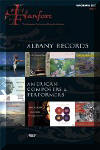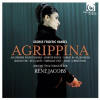Texte paru dans: / Appeared in:

Fanfare Magazine 35:4(03-04/2012)
Pour
s'abonner / Subscription information
Les abonnés à Fanfare Magazine ont accès aux archives du
magazine sur internet.
Subscribers to Fanfare Magazine have access to the archives of the magazine
on the net.
Harmonia Mundi
HMC902088/90

Code-barres / Barcode:
3149020208878
Consultez toutes les évaluations
recensées pour ce cd ~~~~ Reach all the evaluations located for this CD
This is an Agrippina with a difference! For his recording, based on a 2009 production at the Deutsche Staatsoper Berlin, René Jacobs claims to present a “rejected” original version of the opera. In an attempt to justify his edition, Jacobs claims, “Only this Ur-version combines the explosive political topicality of the piece with a dramatic cogency not possessed by the opera actually premiered in Venice.” This claim is, to say the least, highly questionable.
It is uncertain when Handel received the commission to write Agrippina; the most likely period is between winter 1707 and summer 1708. Some Handel scholars, including Friedrich Chrysander, Paul Henry Lang, David Kimbell, Reinhard Strohm, and Bernd Baselt, believe the opera was composed in 1708. Jacobs also supports this date. On the contrary, John Mainwaring, Handel’s first biographer (with whom Handel scholar Winton Dean agrees), states that the music was composed in a period of about three weeks shortly before the premiere (exact date unknown, but almost certainly January 1710).
The main changes occur in the first scene of act III, in which Poppea, in order to be revenged on Agrippina, stages a scene in which Ottone, Nerone, and Claudio are concealed behind curtains in her room (Jacobs incorrectly states in his essay contained in the booklet that it is Ottone and Poppea who hide). In the opera as performed, Ottone and Nerone each sing an aria before they hide; neither aria was part of the original conception. Poppea’s aria “Bel piacere” originally was placed earlier in the scene and set to different words. After Nerone and Claudio come out of hiding and depart, Poppea has an aria, “Esci, o mia vita,” in which she bids Ottone come out of hiding, and the two end the scene with a duet. Before performance, Poppea’s aria was cut, the duet was transformed into an aria for Ottone, and Poppea ends the scene with “Bel piacere.” Jacobs pours scorn on this arrangement, saying it is “more suited to the vanity of the singers and the ‘culinary’ taste of the audience.”
The other major change in text occurs toward the end of act II. Claudio originally began the scene with a short arioso. This was cut, and Claudio was given a full aria at the end of the scene. Jacobs states, “Here too Handel showed himself ready to compromise, with fatal consequences for dramatic flow.” In addition, in four arias in act I, Jacobs shortens the da capo by cutting bars at the beginning of the arias. Some recitative is cut. A few arias are reorchestrated, such as Lesbo’s continuo aria “Allegrezza!” in act I, which has trumpets and timpani added. Giunone’s aria is cut. Jacobs gives one dance at the end (the music is taken from the extended overture to Rodrigo; the original ballet music does not survive and may have been cut).
Jacobs seems to be going to extremes in order to justify his version of the opera. The opera as generally performed is a cogent, logical text, one of the best Handel ever set, whether you agree with Jacobs or not. Both versions of the changed scenes stand on their merit, and there is no need for Jacobs to imply that Handel’s changes were the result of singers’ vanity. Handel throughout his career showed himself to be strong-willed enough to resist demands from singers, no matter how prominent, for changes of which he did not approve. And we have no way of knowing, without any documentary evidence, why Handel changed the score as he did. But such changes were certainly not unknown and could just as easily have resulted from an effort to improve the drama.
A related question concerns the quality of the changed music. Is the opera better as Jacobs presents it or as it has traditionally been performed and recorded? I will leave that determination to purchasers of this recording. In my opinion, Jacobs’s changes do not improve the opera. Winton Dean, in Handel’s Operas: 1704–1726, states, “None of the suppressed pieces is of more than moderate quality.”
Which brings us to the performance itself. The cast is uniformly excellent. No better group of singers has been gathered for any previous Agrippina recording. There are no weak links; all are superb singing actors. In Fanfare 19:5, Bob Rose welcomed the recording debut of Alexandrina Pendatchanska with enthusiasm: “The voice is bright with a tight vibrato and the technique exhibits considerable virtuosity. She has a secure trill, and is most adept in the fioritura passages which she sails into fearlessly and with considerable brio.” She throws herself into the role of Agrippina, sometimes to the point of overacting and occasionally resulting in a shrill or course note or two, but this is an extremely successful assumption. Jennifer Rivera brings a beautiful voice, sure technique, and a decent trill to the role of Nerone. Bejun Mehta is one of the best countertenors before the public, and his assumption of Ottone is up to his usual high standards. Marcos Fink, although a bass-baritone, is equal to the full range of Claudio’s music and smooth in coloratura. And so it goes with the rest of the cast. Sunhae Im, Neal Davies, Dominique Visse, and Daniel Schmutzhard contribute well-sung and -acted performances equal to or better than their competitors on other recordings. The Akademie für Alte Musik Berlin is up to its usual high standards.
Jacobs’s performance of his version of the opera is as controversial as his claimed original version. The tempo of some arias, such as “Tuo ben è’l trono” in act II, is pulled about. The continuo is assigned to an ever-changing (and unhistorical) combination of cello, harpsichord, lute, guitar, and organ! The approach to the recitatives is particularly aggressive. Rarely will the same combination of continuo instruments be heard for more than a few bars at a time. All kinds of effects, such sforzandi and additional bars of music (I almost said improvised, but nothing here is spur-of-the-moment), presumably to comment on the scene, are added in a way that draws attention to itself and away from the text. I am, however, surprised that da capo ornaments are frequently, but not always, tasteful and idiomatic. Basic tempos, when not being pulled about, are generally acceptable, but a few numbers are taken at too fast a clip.
Agrippina has had three previous recordings. Nicholas McGegan was the first to record it, on Harmonia Mundi. It is currently available only as an mp3 download. Next came John Eliot Gardiner on Philips, still available. Finally, Jean Claude Malgoire’s recording from Dynamic is available on CD and DVD. I have not heard the Malgoire. Bernard Jacobson, reviewing the DVD in Fanfare 28:6, pronounced the performance “finely sung and well played” but found the stage production “scenically ludicrous,” which need not concern those who purchase the CDs. Jacobson gave a preference to Gardiner over Malgoire in the final analysis.
Jacobson finds Gardiner’s performance “broadly preferable” to McGegan’s. I must respectfully disagree. I prefer McGegan’s Sally Bradshow (Agrippina) to Gardiner’s Della Jones, his Wendy Hill (Nerone) to Gardiner’s Derek Lee Ragin, and his Drew Minter (Ottone) to Gardiner’s Michael Chance. The remaining singers are of equal appeal, except for Gardiner’s Alastair Miles (Claudio), who is much to be preferred to McGegan’s Nicholas Isherwood.
It is unfortunate that a cast of this quality is tied to Jacobs’s misconception of a performance. This could have been a clear first choice among Agrippina recordings but instead is merely a curiosity. When I want to hear Agrippina, I will turn to McGegan, or occasionally to Gardiner. Jacobs can be recommended only to his die-hard fans and to the curious who want to hear the few rejected numbers from the first draft of the score.
Cliquez l'un ou l'autre
bouton pour découvrir bien d'autres critiques de CD
Click either button for many other reviews


